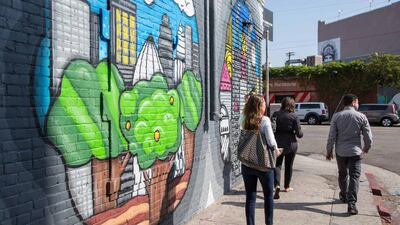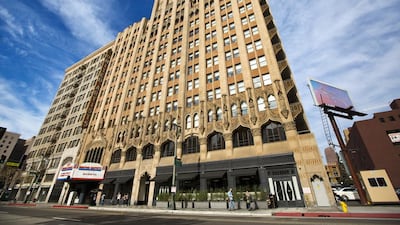Leaving West Hollywood and its green, flowery hills behind, traversing Los Angeles in the dense traffic, I finally arrive on Grand Avenue, the artery slicing between the city’s east and west. Planted on the bustling sidewalk, the opalescent facade of the new Broad museum shimmers in the golden Californian sun. Inside, a labyrinth of concrete curves echo the giant metal sheets of the Frank Gehry-designed Walt Disney Concert Hall across the street. Farther along, the green- and brick-coloured bunker designed by Arata Isozaki in 1986 for the Museum of Contemporary Art pioneered a shift in the area’s cultural scene, establishing a new creative hub in the shadows of the glitzy Hollywood scene.
Now, with the opening of museums, trendy boutique hotels and restaurants, hip stores, and even a Soho House outpost, Downtown has become a destination of its own, stretching from the skyscrapers, malls and museums along Grand Avenue to the busy bars of the Historic Core, the formerly deserted industrial areas east of Little Tokyo, to the banks of the Los Angeles River, where the Arts District has risen.
On my way to check in at the Ace Hotel, I pass Urban Outfitters, Acne Studios and New York design-forward importer Oak. Since its opening in 2014, the Ace has become a cultural centre of its own, with DJ nights and live music on the rooftop terrace, and performances by the likes of Patti Smith, David Byrne and Benjamin Millepied at the adjacent live venue, a historic movie palace. I start on the terrace, surrounded by a young, bohemian crowd, then head to the ground-floor restaurant, managed by the team of Brooklyn-based Australian hit Five Leaves, for grilled octopus, scallop risotto, spring pea ravioli and duck breast.
When it’s time to hit the pillows, my room feels like a fun dorm, with a large bed set just above the carpet, vintage-style letter paper and plenty of candy, drinks and toys to play with. The floor-to-ceiling window looks out onto the construction sites all around. Downstairs, the lobby shop sells industrial-style parkas, locally made bathrobes, exclusive Pendleton plaid blankets and artisanal soaps. Next to me is celebrity chef Marcus Samuelsson, of Red Rooster fame in Harlem. He’s excited to go back to the nearby Grand Central Market, recently renovated, to peruse local produce and taste dishes from gourmet stands. That night, he’s cooking in Venice, a few blocks from the beach.
Later, I walk down the street to Perch, a plush lounge in a historic building facing Pershing Square. A young crowd of entrepreneurs mingle on the roof and around the massive bar, a sure sign of the definitive gentrification of an area that just a decade ago grappled with serious socio-economic strife.
While the zone was considered by many to be a no-man’s-land, in the 1970s, artists began moving there, lured by its open spaces and streets, taking over abandoned industrial lofts and vacant Art Deco buildings. With a nascent artistic scene, underground happenings and DIY spaces, downtown rose again. Paul McCarthy, George Herms and now Sterling Ruby and Vincent Gallo are among the leading figures of this ecosystem.
But the misery is still there, a stark contrast with the lavish restaurants, boutiques, and loft-style dwellings. As rents rise, LA struggles with managing its growing homeless crisis, and tent cities appear all over. Skid row is ravaged by drug addiction and shocking poverty.
Meanwhile, developers and city officials are determined to reshape these vast areas into high-end destinations. The Arts District, formerly an industrial area conducive to artists’ needs, is filled with art galleries and small cafes next to massive graffiti murals and, again, reminders of the city’s crushing homeless crisis. This is where the 116,000-square-foot gallery Hauser Wirth & Schimmel opened last year in a former flour mill complex, complete with a garden and chickens. With a restaurant and two bookstores, plus substantial exhibition space showcasing major local artists such as Mark Bradford and Richard Jackson, it has become a destination and helped shape LA’s place as a new art capital – New York’s other pole.
Nearby are many more cultural venues, such as the 365 gallery; Mama Gallery, which shows young local artists; and The Box, the multidisciplinary space opened by Paul McCarthy’s daughter, Mara. Along with the art spaces came a series of spots to feed the area’s newcomers. Bestia, a stylish, elegant spot, serves wood-fired Italian specialities to the rising cultural population of the area. At Bread Lounge, baker Ran Zimon makes his delicious baguettes and buttery, caramelised Breton pastry kouign-amann. Robust espressos, along with fresh sandwiches and salads, help fuel lively interactions at the Daily Dose on Industrial Street. Several coffee companies have recently opened major outposts here, including Stumptown, Blue Bottle, Urth Caffe and Wheelhouse, a community-orientated bike and coffee shop also selling designer bike wear and high-end coffee gear.
Where do LA hipsters dress? They buy their Warby Parker architect’s glasses at Alchemy Works, where the industrial-style Glass House designed by the brand also offers custom glassware from local vendors. Hyperconscious “global citizens” shop for chinos and raw indigo wool jackets at Apolis Common Studio, which promotes a socially conscious ethos. And to fill the newly renovated lofts, Hammer and Spear sells a personalised selection of vintage and designer objects including velvet lounge chairs and amber resin potpourri.
Nearby is local architect Michael Maltzan’s sparkling new One Santa Fe complex, an elongated white-and-red vessel that cost US$165 million (Dh606m) to build. Maltzan is also building a new bridge in the area. Residents can practise in its Pilates studio, linger in its zero-edge saltwater pool, and shop at the bookstore, which has a cult following on the West Coast, and all-local neighbourhood markets for artisanal doughnuts. Visit before the mega malls, massive developments and tech companies completely take over.
Shirine Saad is the author of Boho Beirut: A Guide to the Middle East’s Most Sophisticated City.
travel@thenational.ae





